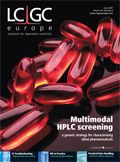The Brit Pack
LCGC Europe
Research group: Professor Jane Thomas-Oates, Analytical, Environmental and Atmospheric Chemistry, Department of Chemistry, University of York, York.
Research group: Professor Jane Thomas-Oates, Analytical, Environmental and Atmospheric Chemistry, Department of Chemistry, University of York, York.
Research Focus: The section focuses on the development of analytical methods, principally centred on separations science and mass spectrometry (MS) and their application in biomolecular and environmental research. Large, interdisciplinary collaborations are central to the research of all groups in this section. There are five main research groups in the section led by Dr Lucy Carpenter, Professor David Goodall, Dr Brendan Keely, Professor Ally Lewis and Professor Jane Thomas-Oates (section head).

Dr Lucy Carpenter's research focuses on analysing some of the reactive gases in the atmosphere, in particular those containing halogen groups at sub-parts per trillion (ppt) levels, to understand more about their atmospheric chemistry and the mechanisms for their release. In the field, the team automatically preconcentrate analytes from litres of air for analysis by gas chromatography–mass spectrometry (GC–MS). One of the major challenges is determining accurate concentrations at such low levels. The team use in-house integration programme to improve on quantific, and have designed in situ calibration methods for these very reactive gases using dynamic dilution of primary permeation sources.

Jane Thomas-Oates
Professor David Goodall's research is focused on the development and applications of novel miniature ultraviolet (UV) area imaging detectors based on active pixel sensor (APS) technology. APS devices are effectively cameras on chips, and our innovations allow them to be used in applications including real time visualization of separations and reactions and multiplexed detection in capillary electrophoresis (CE) and nanobore liquid chromatography (nanoLC).

Lucy Carpenter
Key activities in Dr Brendan Keely's group involve the development and application of hyphenated mass spectrometric and tandem mass spectrometric methods (MS–MS) for analysis of complex mixtures. Applications include the profiling of photosynthetic pigments in sediment cores to provide detailed records of environmental change over geological timescales, development of rapid screening methods to detect the use of steroid hormones in meat production and development of new methods for analysis of pesticide residues in foods. All three methods utilize the capabilites of tandem mass spectrometry to provide assignment or confirmation of analyte identity.

David Goodall
Professor Ally Lewis's group develops multidimensional chromatographic techniques such as LC–GC and GC×GC for very high complexity mixture analysis in the environmental, petrochemical, combustion and natural product research areas, supported by mass spectrometric methods including time-of-flight (TOF) and ion trap (IT). The research group also has activity in field instrument development and the miniaturization of chromatographic devices.

Brendan Keely
Professor Jane Thomas-Oates's group works in the post-genomic fields of proteomics, metabolomics and glyco(proteo)mics. This team are developing nanoLC–MS–MS methods, principally using less conventional column chemistries, for applications in these areas. Recent work has focused on developing and applying capillary polystyrene-divinylbenzene monolith-based methods for increasing the sensitivity of peptide identification in proteomic studies, and porous graphitized carbon and Zwitter ionic column hydrophillic interaction chromatography (ZIC-HILIC) approaches for glycomic and metabolomic applications.

Ally Lewis
www.york.ac.uk/depts/chem/research/analytical.htm
E-mail: jeto1@york.ac.uk
Research Group: Professor Norman Ratcliffe, Centre for Research in Analytical, Material and Sensor Sciences, University of the West of England, Bristol.

Norman Ratcliffe
Research Focus: The group's activities are targeted at the analysis of volatile organic compounds (VOCs) from biological sources to diagnose diseases. The team have investigated vapour profiles from vegetables, including carrots, potatoes, grain and citrus fruit, and compared diseased and healthy specimens using preconcentration methods followed by gas chromatography mass spectrometry (GC–MS).
The identification of key volatile markers has enabled the identification of sensors targeted at these volatiles and led to the introduction of low-cost electronic nose technology to detect, for example, soft rot detection in potato tubers in potato stores. This research was undertaken with the aid of funds from the British Potato Council (BPC). The department of environment, food and rural affairs (DEFRA)-funded research has recently focused on brown rot and ring rot detection, which are serious pathogens. The team has also collaborated with the Campden and Chorleywood Food Research Association (CCFRA) to analyse VOCs from fungal infected grain and successfully built an electronic system for wheat assessment, with funding from the Home Grown Cereals Authority (HGCA).
With Wellcome Trust support the group are using adsorption thermal desorption (ATD–GC–MS) to identify volatile biomarkers from diarrhoea and a key goal of this project is to build device for rapid diagnoses of the pathogens Clostridium difficile and campylobacter; the former is responsible for a significant number of deaths in hospitals. Other projects involve the analysis of stool VOCs for bowel cancer detection, urine VOCs for prostate cancer detection and breath for liver disease diagnoses.
E-mail: Norman.ratcliffe@uwe.ac.uk
Research group: Professor Roger Smith, Department of Chemistry, Loughborough University, Loughborough, Leicestershire.

Research focus: The separations group at Loughborough have examined a variety of areas of chromatography, including an EU project on the development and testing of a reference column for high performance liquid chromatography (HPLC) and retention prediction in capillary electrophoresis (CE). The group is currently focusing on the use of temperatures up to 250 °C as a variable in liquid chromatography (LC). Following earlier studies on supercritical fluid chromatography (SFC) and extraction using carbon dioxide, there has been particular interest in the use of superheated water as both an environmentally friendly elution solvent and also as an extraction solvent. The analytes studied have included many pharmaceuticals, food components, such as vitamins and sugars, phenols, amines and agrochemicals. The work has explored the stability of a range of stationary phases at high temperature and of the scope for the rapid heating of HPLC columns so that temperature programming can replace eluent gradients.
The studies have also included an examination of the advantages of organic solvent-free eluents in detection. This has enabled studies on the use of liquid chromatography–nuclear magnetic resonance spectroscopy (LC–NMR) with deuterium oxide as a signal-free solvent and the coupling of LC through a nebulizer to a flame ionization detector (FID) to provide universal detection for compounds with and without chromophores.
Other recent research at Loughborough has involved on-column metal complexation, sampling methods in food and forensic drug analysis, and two-dimensional liquid chromatography (2D LC).
www.lboro.ac.uk/departments/cm/staff/smith.html
E-Mail: R.M.Smith@lboro.ac.uk
Research Group: Professor Peter Myers, Department of Chemistry, University of Liverpool, Liverpool.

Peter Myers
Research focus: Peter Myers, with the support of ThermoFisher, is establishing a group at the University of Liverpool to try and establish a new base for chromatographic research in the UK. The group's initial research will be divided into four main areas: new manufacturing methods for high-performance liquid chromatography (HPLC) and gas chromatography (GC) support materials, Lab-on-a-CD, supercritical carbon dioxide bonding and dynamic field gradient focusing (DFGF).
In terms of new manufacturing methods the team will investigate novel methods to create HPLC support materials that do not use the classic sol-gel approach to manufacture particles of a given size, surface area and porosity.
They are also looking at using CDs as new separation platforms in that liquid can be moved around the CD and driven through separation columns using centrifugal force. These Lab-on-a-CD platforms have the potential to provide new portable LC units.
The group will also focus on supercritical carbon dioxide as a bonding medium to generate new stationary phases. The use of carbon dioxide has obvious environmental advantages over other commonly used solvents. The work stems from research initially performed at the University of Leeds by Keith Bartle, Tony Clifford and Peter Myers that showed significant increases in ligand bonding density on silica resulting in major improvements in chromatographic properties of the silica.
The other main area of interest is dynamic field grade focusing (DFGF) in which charged molecules are focused in a column at a point where their electrophoretic mobility is balanced against an opposing hydrodynamic flow. DFGF offers some unique advantages over other electrically enhanced separation methods such as CE and CEC, which are adversely affected by bubble formation and change of pH.
DFGF is different from any other separation technique because the separation can be changed dynamically in the run by controlling the electric field gradient profile. Because DFGF separates molecules on their electrophoretic motilities as opposed to their charge it provides a separation strategy that is orthogonal to other forms of chromatography.
E-mail: peter.myers@liverpool.ac.uk
Research group: Dr Richard Ansell, Physical and Analytical Chemistry Department, School of Chemistry, University of Leeds, Leeds.

Dr Richard Ansell
Research focus: The group focuses on two main areas of separations-related research: molecularly imprinted polymers and electrophoretic field-gradient focusing (FGF).
Molecularly imprinted polymers are prepared using a templating process where the analyte of interest, or a related structure, is used to direct the polymerization of functional monomers then removed, leaving selective binding sites behind. The molecularly imprinted polymers (MIPs) have been exploited as selective solid-phase extraction (SPE) matrices and chiral stationary phases (CSPs) in high performance liquid chromatography (HPLC) and capillary electrochromatography (CE).
The group also specializes on understanding and improving the imprinting process by investigating the monomer–template interactions and by designing new functional monomers. They have extended the use of MIP CSPs to supercritical fluid chromatography (SFC). FGF is a novel separation technique where a constant hydrodynamic flow is opposed by a curved electric field.
Analytes with different electrophoretic mobilities focus at points where the electrophoretic and hydrodynamic forces acting on them are equal and opposite. In collaboration with Professor Peter Myers from the University of Liverpool, UK and Professor Cornelius Ivory from Washington State University, USA the group has developed a new instrument capable of separating dyes and coloured proteins using this method. Current work is directed towards in-channel detection of uncoloured proteins and post-column analysis by mass spectrometry (MS).
www.chem.leeds.ac.uk/People/RJA/anselllabframe.htm
E-mail: R.J.Ansell@leeds.ac.uk
Research group: Dr Lorraine Gibson, Analytical Chemistry, Department of Pure and Applied Chemistry, University of Strathclyde, Glasgow.

Dr Lorraine Gibson
Research focus: The focus of the Strathclyde research group is to provide solutions to problems experienced in cultural heritage science. Various programmes of research have been implemented and involve stability studies, archaeological conservation and the development and/or application of micro- and non-destructive methods of analysis for the technical examination of works of art. A driving force for the research is to understand the relationship between artefact stability and indoor air pollution and artefact damage.
One specific project led to the identification of a new mineral to science, called 'thecotrichite'. This calcium acetate chloride nitrate pentahydrate mineral grows as an efflorescence salt on the surface of susceptible calcareous museum items exposed in environments contaminated with acetic acid vapour (a phenomenon that occurs in tightly sealed wooden enclosures). Stoichiometric identification of the mineral was achieved by ion chromatographic analysis of the salt solution. Other materials under study include shells, cellulose nitrate and cellulose acetate.
To prevent further pollution-induced deterioration of similar items novel passive samplers were developed to detect common indoor air pollutants (acetic acid, formic acid and formaldehyde vapour). Detection and quantification of the insidious pollutants were achieved by post-analysis of the trapped analytes with ion chromatography (IC) and high-performance liquid chromatography (HPLC). Where high pollutant levels have been measured, mitigation methods are employed to reduce concentrations. Improved sorbents have been synthezised to provide mesoporous silicates that simultaneously extract common volatile organic compounds (VOCs) and formaldehyde. Extraction efficiency tests are performed in environmental chambers and quantification is achieved by thermal desorption–gas chromatography–mass spectrometry (TD–GC–MS).
Other areas of research include assessing the stability of archival materials.
www.chem.strath.ac.uk/people.php?id=bas99132
E-mail: lorraine.Gibson@strath.ac.uk
Regulatory Deadlines and Supply Chain Challenges Take Center Stage in Nitrosamine Discussion
April 10th 2025During an LCGC International peer exchange, Aloka Srinivasan, Mayank Bhanti, and Amber Burch discussed the regulatory deadlines and supply chain challenges that come with nitrosamine analysis.













